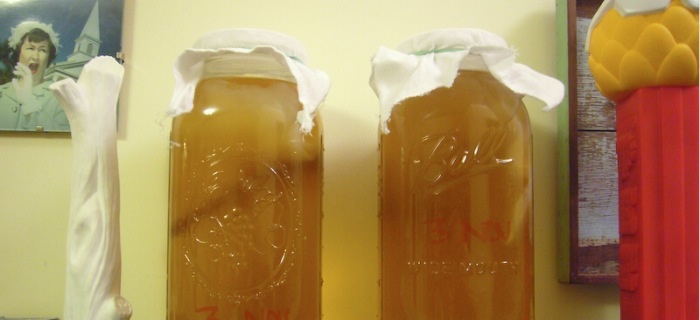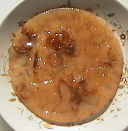How to Brew Kombucha

What is THAT!" hollered Josie when I opened the box we'd just gotten in the mail. Floating in the plastic bag inside was a whitish disk with brownish threads hanging from it that looked more than a bit like a very flat jellyfish.
"That," I said, "is a kombucha...thingie," I finished lamely. How to explain to a child what a symbiotic collection of bacteria and yeast (aka "scoby") is? Because that's what we'd just gotten in the mail, a "thingie" commonly called a kombucha mushroom, even though it's not a mushroom at all.
"It looks like an alien!" yelled Jo. Maybe it is, added her father. One thing led to another, and we named our scoby Gonzales--Alien Gonzales, get it? Never mind. Suffice it to say that as quickly as we could, we put Gonzales to work in a gallon jar of strong sugared tea on the counter, where a Gonzales descendent has been happily brewing ever since for the last two years.
Why, you may be asking yourself, do you have an alien-like organism floating in a vat of sweet tea in your kitchen? Ah, so that it will turn the tea into kombucha, a drink with both amazing flavor and amazing powers for healing. Or at least so its adherents (and a couple of studies) say.
I'm one of its adherents. When I'm regularly drinking kombucha, my digestion is better, my skin improves and my blood sugar seems more stable. When I first started drinking it, my gray hair even started coming back dark, but that was a passing trend at best. All of this is completely subjective in my case; I have no clear proof that drinking kombucha did any of this definitively and of course Your Mileage May Vary. But I can tell you definitively that kombucha is delicious and cheap to make yourself. You can pay upwards of $3 for a small bottle of it at the health food store, or for the price of five plain old tea bags and a cup of sugar make a big batch of it yourself for pennies a bottle.
Making Kombucha The first step in brewing kombucha is to obtain a scoby; see Gonzales there to the left on a salad plate waiting to be put in a new jar of tea. I bought Gonzales mail order, but here's the thing about scobies: Every time you brew kombucha you get a new one. (That's not actually Gonzales; it's something like Gonzales XXIV.) It should be easy if you live in a larger area to find someone with a spare scoby to give away through Freecycle or Craigslist--heck, just email your friends and I bet you'll turn one up. If, however, you're out in the middle of scoby-less territory, I bought mine at Kombucha.org, which is also a good source of information. You can also try the International Kombucha Exchange, where you'll find people who will give scobies away. When you get your scoby, make sure the person gives you at least a cup of kombucha as well.
The first step in brewing kombucha is to obtain a scoby; see Gonzales there to the left on a salad plate waiting to be put in a new jar of tea. I bought Gonzales mail order, but here's the thing about scobies: Every time you brew kombucha you get a new one. (That's not actually Gonzales; it's something like Gonzales XXIV.) It should be easy if you live in a larger area to find someone with a spare scoby to give away through Freecycle or Craigslist--heck, just email your friends and I bet you'll turn one up. If, however, you're out in the middle of scoby-less territory, I bought mine at Kombucha.org, which is also a good source of information. You can also try the International Kombucha Exchange, where you'll find people who will give scobies away. When you get your scoby, make sure the person gives you at least a cup of kombucha as well.
Once you have your scoby, you'll want to keep it in the fridge in the kombucha it came in until you're ready to use it. Store it in glass if at all possible; plastic can leach into the kombucha, and metal is reactive with its acids. I have a Corningware container I keep mine in.
To brew your kombucha you need:
- 3 1/2 quarts of filtered water--the chlorine in tap water can hurt your scoby! Filter the water through a Brita or other water filter, let it sit out overnight to let the chlorine evaporate (happy thought, no?) or use bottled water. Doesn't have to be distilled, just non-chlorinated.
- 1 cup regular old white sugar
- 5 regular old black tea bags--you can get as fancy as you like with the tea, but I use garden variety restaurant supply tea bags. Red Rose, Lipton, whatever. AVOID ARTIFICIALLY FLAVORED TEAS like Earl Grey or Constant Comment. If you want to experiment with flavor, try different kinds of tea like green or white, or substitute a bag of herbal or spice tea for one of the black tea bags. I like putting in a bag of Yogi Tea. Just make sure the bulk of the tea is camellia sinensis--the plain old tea plant--in some form.
- A large pot
- A gallon-sized glass jar
- A piece of cloth that will cover the top of the jar
- A rubber band or something similar that is big enough to go over the mouth of the jar
- Your scoby and at least 1/2 cup of leftover kombucha from your last batch
Be sure your hands and equipment are very clean. Bring the water to a boil in the large pot. Once it's come to a boil, turn off the heat, dump in the sugar and add the five tea bags. Set your timer for 15 minutes and take out the tea bags once it goes off. Put the lid on the pot and leave it to cool. I usually leave it overnight.
Once your tea is cool, pour it into the glass jar. Wash your hands well, take up your scoby gently and slide it into the tea. Add at least a half-cup of already-brewed kombucha. If you don't do this, the tea won't be acidic enough and it'll mold. Cover the top with the cloth and fasten the cloth with the rubber band. It's important to put the rubber band on to keep out fruit flies, and the kombucha needs air so don't be tempted to just put a regular lid on. Put the jar in a dark, warm place in your kitchen. I don't go out of my way; I have a hallway pantry where I do all my ferments and it's not especially warm but it is out of the sun. Cooler places mean a longer ferment time, that's all. Forget about your kombucha for at least a week.
After a week, check on your jar. You should see a new scoby forming at the top. If you see green mold, your tea wasn't acidic enough. Take out the scoby and start over. If the mold is just on the tea, not the scoby, you won't have to throw the culture out too, but if it's on the scoby, you're back to square one. This has only happened to me once in two years.
Your kombucha is through brewing when the new "baby" scoby is at least 1/8" thick. You will know in time how long to leave your kombucha on to brew; the longer you leave it, the more sour it gets, and you'll learn how long to leave it to get it just right for your taste. We like it half-sweet half-sour and fizzy.
Oh yes! The fizzy part. Or:
Storing Your Kombucha
Yes, kombucha is naturally carbonated! To keep the carbonation in, I use bottles called EZ Caps. Some imported beers come in bottles like this--Grolsch is one--so if you know any beer connoisseurs see if you can talk them into drinking a case for you and saving the bottles. Freecycle might also be a source for these bottles. (The green one in the picture at the top is a Grolsch bottle a friend gave me.) If not, you can buy them at most wine and beer brewing supply houses. They're not too expensive and you'd be amazed how handy they are; I don't know what I did without EZ Caps around.
In any event, whatever you decide to do, store your kombucha in glass. Metal is reactive and plastic can leach into the kombucha. If you don't want to use EZ Caps I'd suggest mason jars with plastic lids, but I can't say that it'd keep the fizz in very well. Keep it in the fridge. It stores pretty much indefinitely. Over a long time it may grow a tiny scoby at the top of the bottle, and it may get more sour, so keep that in mind. If it gets too sour, it makes a good vinegar substitute in salad dressings. (DO NOT use it in pickling/canning; it has too variable a pH.)
Drinking Kombucha
Some people find that they're sensitive to kombucha at first; it can give you stomach rumbles and be fairly, uh, cleansing to the bowels shall we say. It's suggested you drink no more than two ounces a day until you know how your body handles it. I have worked up to being able to drink a whole 16 oz. EZ Cap bottle at a go, mostly in the summertime because it's so dang refreshing, with no ill effects, though when I first drank it I did have a bit of a rumbly tummy--not bad, and not at all painful, but my internal flora were definitely adjusting. That's to the good; properly brewed kombucha is one of the best of the probiotics.
But mostly, kombucha tastes great! It's healthy, delicious and cheap. What more could you want from a science project?
Lynn Siprelle edits this site.
